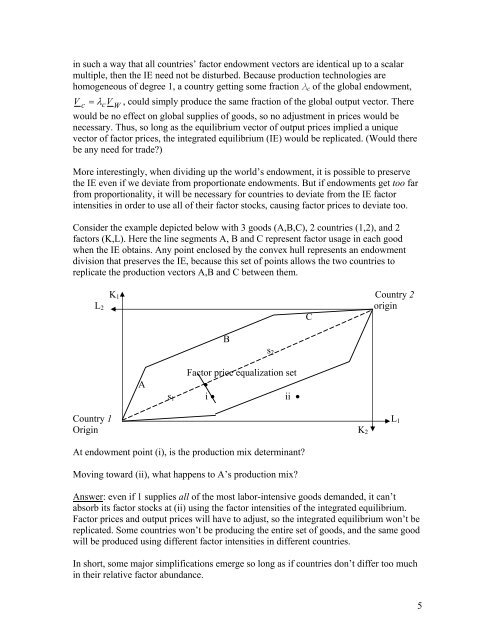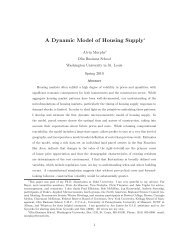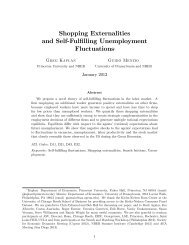1 J. Tybout Topics in International Trade (Econ 507B) Lecture 1 ...
1 J. Tybout Topics in International Trade (Econ 507B) Lecture 1 ...
1 J. Tybout Topics in International Trade (Econ 507B) Lecture 1 ...
Create successful ePaper yourself
Turn your PDF publications into a flip-book with our unique Google optimized e-Paper software.
<strong>in</strong> such a way that all countries’ factor endowment vectors are identical up to a scalarmultiple, then the IE need not be disturbed. Because production technologies arehomogeneous of degree 1, a country gett<strong>in</strong>g some fraction 8 c of the global endowment,V c= λ , could simply produce the same fraction of the global output vector. TherecVWwould be no effect on global supplies of goods, so no adjustment <strong>in</strong> prices would benecessary. Thus, so long as the equilibrium vector of output prices implied a uniquevector of factor prices, the <strong>in</strong>tegrated equilibrium (IE) would be replicated. (Would therebe any need for trade?)More <strong>in</strong>terest<strong>in</strong>gly, when divid<strong>in</strong>g up the world’s endowment, it is possible to preservethe IE even if we deviate from proportionate endowments. But if endowments get too farfrom proportionality, it will be necessary for countries to deviate from the IE factor<strong>in</strong>tensities <strong>in</strong> order to use all of their factor stocks, caus<strong>in</strong>g factor prices to deviate too.Consider the example depicted below with 3 goods (A,B,C), 2 countries (1,2), and 2factors (K,L). Here the l<strong>in</strong>e segments A, B and C represent factor usage <strong>in</strong> each goodwhen the IE obta<strong>in</strong>s. Any po<strong>in</strong>t enclosed by the convex hull represents an endowmentdivision that preserves the IE, because this set of po<strong>in</strong>ts allows the two countries toreplicate the production vectors A,B and C between them.L 2K 1 Country 2orig<strong>in</strong>CBs 2AFactor price equalization set•s 1 i • ii •Country 1 L 1Orig<strong>in</strong> K 2At endowment po<strong>in</strong>t (i), is the production mix determ<strong>in</strong>ant?Mov<strong>in</strong>g toward (ii), what happens to A’s production mix?Answer: even if 1 supplies all of the most labor-<strong>in</strong>tensive goods demanded, it can’tabsorb its factor stocks at (ii) us<strong>in</strong>g the factor <strong>in</strong>tensities of the <strong>in</strong>tegrated equilibrium.Factor prices and output prices will have to adjust, so the <strong>in</strong>tegrated equilibrium won’t bereplicated. Some countries won’t be produc<strong>in</strong>g the entire set of goods, and the same goodwill be produced us<strong>in</strong>g different factor <strong>in</strong>tensities <strong>in</strong> different countries.In short, some major simplifications emerge so long as if countries don’t differ too much<strong>in</strong> their relative factor abundance.5
















